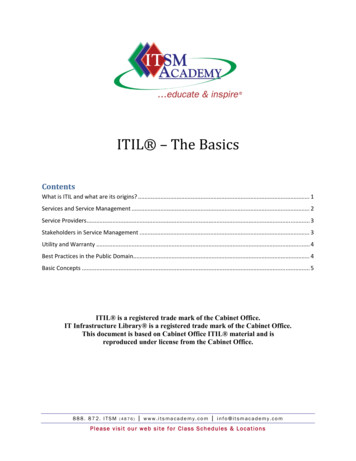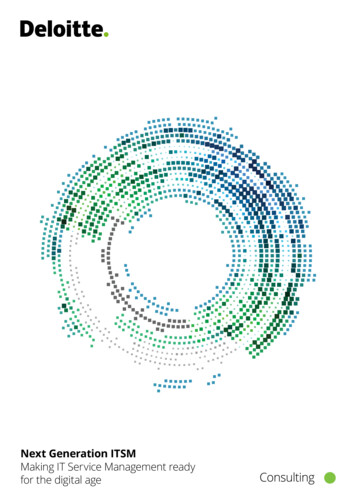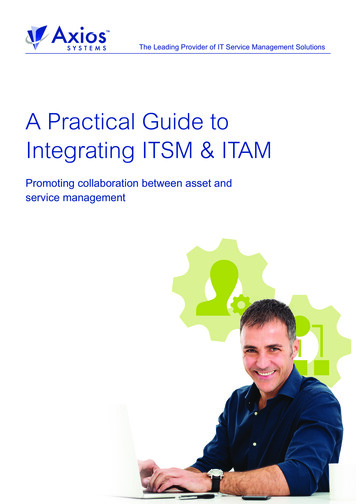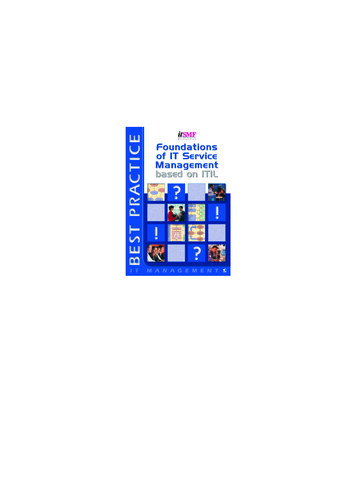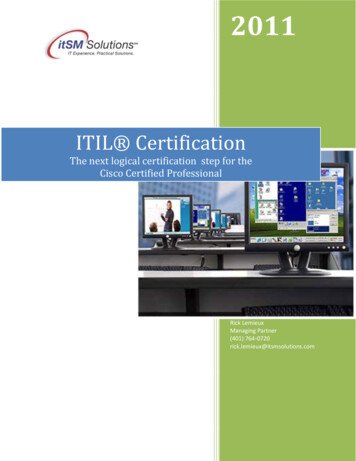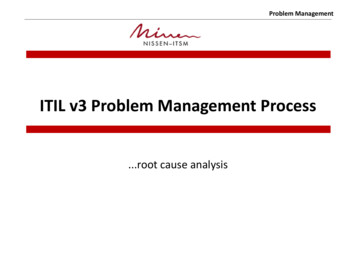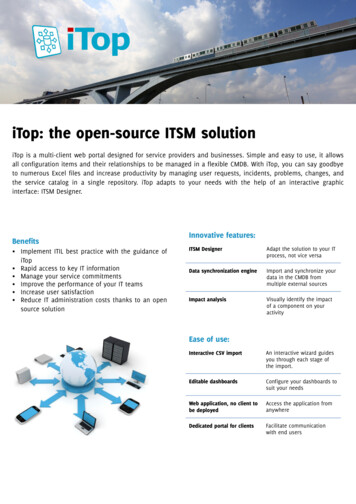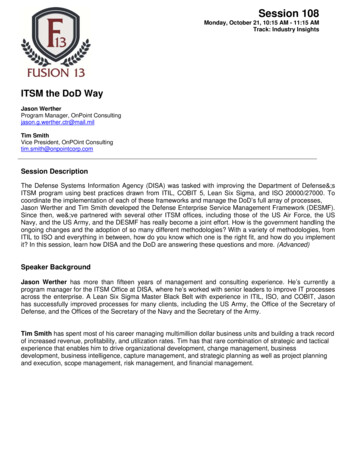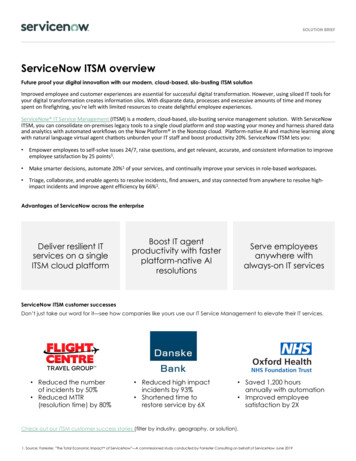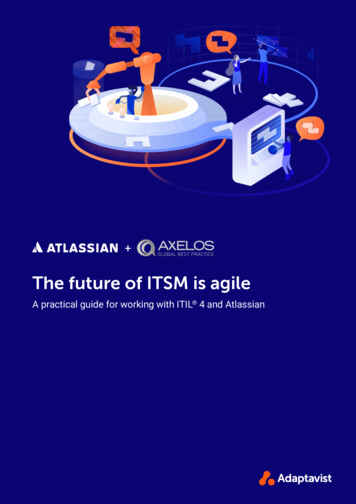
Transcription
The future of ITSM is agileA practical guide for working with ITIL 4 and Atlassian
The future of ITSM is agileA practical guide for working with ITIL 4 and AtlassianContentsIntroduction3The Atlassian ITSM solution5A holistic approach to performance, culture, and practices6Unite around the right performance strategy6Unleash your team’s full potential through culture9Change behavior by adopting flexible practices12General management practices15Continual improvement with retrospectives15Agile project management to speed up project delivery19Knowledge management to empower team culture22Service management practices24Customer-centric service desk and request management24Adaptive incident management27Streamlined change control through automationand collaboration31Technical management practices35Continuous delivery for deployment management35Integrated software development and operations teams38Conclusion40About the authors422
IntroductionWelcome to a new world. As the role of digital is increasingin every company, most services today are enabled by IT.What’s even more exciting is that IT teams sit at the centerof this transformation. From cloud computing toblockchain to AI and IoT, new technologies have explodedin the past decade. They have served as a catalyst for newways of working, led by agile, lean, and DevOpspractitioners.To keep up in this world, IT organisations are finding ways to increaseorganisational agility while balancing the need for stability andpredictability. They are switching to more agile approaches that valueease of use, collaboration, and knowledge sharing over complex,inflexible workflows.Enter ITIL 4. Developed “for the community, by the community,” thelatest update of the IT Library Infrastructure (ITIL) was crowdsourcedfrom the viewpoints and best practices of over 2,000 global ITprofessionals across roles, industries, and communities, including agileand DevOps. The design principles that drove this developmentfocused on creating a more lean and practical guide that adapts to newtechnology and incorporates emerging ways of working in parallel tocore IT Service Management (ITSM) practices.3
ITIL 4 helps IT service teams and individuals understand:· How the service economy works in the modern world· How to keep a value-first mindset using the ITIL Guiding Principles· How to integrate lean, agile, and DevOps techniques into ITSM· How to create simple and practical value streams to respondto customer demand and co-create value for all your relevantstakeholders· How to develop practices that balance outcomes with risksITIL 4 is the beginning of a new paradigm shift for IT teams. It guidesteams into a holistic, business and customer-value frame of reference,and encourages a more adaptable approach based on what your teamneeds, and how your team works. The ITIL 4 Guiding Principlesencourage collaboration, simplicity, and feedback.In this guide, Atlassian and AXELOS (the author of ITIL Foundation)have partnered to jumpstart your agile journey with ITIL 4. Based on theprinciples in ITIL 4, you’ll learn how to build a high-velocity service teamthrough performance, culture, and practices. Then we’ll dive into the toppractice areas Atlassian has found that have the biggest impact intransforming the ways IT teams work. Along the way, you’ll get tips onhow to bring best practices from agile and DevOps into ITSM.4
The Atlassian ITSM solutionAtlassian provides the technology backbone with the most criticalcollaborative workflows—agile project planning, incident managementand response, and service management and support—to help modernIT organisations plan, build, deliver, and ensure that your services arealways on. Our products serve over 119,000 customers of all shapesand sizes, in virtually every industry.erPlanlivDeSupporpeOildratetBuAll teams have the potential to do amazing things when work is open.Central to our values, “open work” is in the DNA of our products and webring it to life through our practices. Through our experience workingwith high-performing teams, combined with research and discoveriesfrom implementing an open way of working in our own organisation, wecreated the Atlassian Team Playbook. It’s made up of step-by-stepinstructions for tracking your team’s health, and new ways of working(“plays”) that transform the way we work.5
Our approach to ITSM provides the essentials out-of-the-box, integratedwith a broad ecosystem of best-in-class apps. Instead of legacy toolswith complex and inflexible workflows, our ITSM solution focuses onease of use, collaboration, and knowledge sharing, so IT teams cangain efficiencies, stay nimble, and focus on delivering value.A holistic approach to performance, culture, and practicesUnite around the rightperformance strategyA high-performance strategy is one that enables an organisation toconsistently outperform competing alternatives over time, across businesscycles, during industry disruptions, and when changes in leadership occur.It should be focused on what needs to be done across the organisation tofacilitate value creation.ITIL Foundation: ITIL 4 Edition, 5.1.12, Strategy managementAs your IT teams grow, they face an ever increasing volume ofwork—requests, defects, incidents, and much more—that can trap themin a cycle of reactive and unplanned work. To move from cost-centre tovalue-centre, consider your performance strategy. High performingteams are able to shrink the amount of work and make the flow of workfaster so they can focus on work that matters.ITIL 4 introduces the concept of a service value chain, which representsthe activities that anyone, from a single developer to an entire6
enterprise, can undertake to create valuable products and servicescustomers use.ITIL Foundation: ITIL 4 Edition, Figure 4.2, The ITIL service value chainPlanDesign andtransitionDemandEngageObtain/buildDeliver andsupportProductsand servicesValueImproveBuilding on the service value chain model, ITIL recommends creatingvalue streams, or journeys through various activities of the value chain,that allows the service provider to convert demand into value.Organisations will usually have multiple value streams, one for eachscenario. Examples of value stream scenarios include deliveringcustomer support, introducing new features, and dealing withcybersecurity alerts. Using a map of the activities, optimise your valuestream over time by finding ways to eliminate inefficiencies andbottlenecks to improve the speed of service delivery.7
Example of a value stream for customer support that requires a software fix.PlanDesign andtransition4DemandEngage351Obtain/buildDeliver andsupportProductsand servicesValue2ImproveThe way you measure performance will determine whether your team isworking towards the right goals. But many organisations havemistakenly used Key Performance Indicators (KPIs) as performancetargets. When teams prioritise KPIs like time to resolution or ticketvolumes, they are focusing on meeting internal objectives rather thancustomer or business outcomes.To solve this, organisations including Atlassian have started usingObjectives and Key Results (OKRs) in addition to KPIs. OKRs are tied tolarger company goals, and can be created by answering, “What can wedo to make the biggest impact on customers and the business in thecoming quarter?” By identifying three to five OKRs, you can prioritiseoutcomes that align with business goals during the planning horizon.8
Unleash your team’s fullpotential through cultureCulture is a set of values that is shared by a group of people, includingexpectations about how people should behave, ideas, beliefs, and practices.ITIL Foundation: ITIL 4 Edition, 5.1.12, GlossaryEver wonder why your organisation uses the “right” tools andprocesses, but still fail to see results? The missing link is culture, whichis defined by the shared values, attitudes, and behaviours that drive theway work is done. Culture plays an important role in unlocking yourteam’s potential to perform well and innovate. For modern IT teams, ahealthy culture that’s open and transparent enables you to build aresilient organisation that can quickly adapt to change.The Westrum Organisational Model is a framework shared in The 2018State of DevOps Report that helps us understand the types of culturalbehaviors that drive performance. “Generative,” or performanceoriented teams, demonstrate shared values often represented inDevOps and agile communities. These high performing teams promotecooperation, surface problems quickly, break down silos, embracelearning from failure, and continually experiment to drive improvement.On the other hand, power- and rule-oriented teams, are marked byhabits and attitudes that discourage cooperation, sharedresponsibilities, bridging across boundaries, failure, and novelty.9
Westrum organisational ientedGenerativePerformance-oriented Low cooperation Modest cooperation High cooperation Messengers ‘shot’ Messengers neglected Messengers trained Responsibilities shirked Narrow responsibilities Risks are shared Bridging discouraged Bridging tolerated Bridging encouraged Failure leads toscapegoating Failure leads to justice Failure leads to inquiry Novelty leads toproblems Novelty implemented Novelty crushedChanging your organisation’s culture can be daunting, and it doesn’tusually happen overnight. But through small, incremental steps, youcan start changing the way work is done on your team.1. Use the ITIL 4 Guiding Principles as a starting point to define yourown core values. In fact, you may notice similarities between the ITIL 4Guiding Principles and The Agile Manifesto. So, by embracingprinciples like, “Focus on Value,” “Collaborate and Promote Visibility,”and “Think and Work Holistically,” you’re already one step closer tobuilding a more agile culture!10
ITIL 4 and AGILE principles comparedThe ITIL 4 Guiding PrinciplesThe Agile Manifesto Focus on value Individuals and interactions overprocesses and tools Start where you are Progress iteratively with feedback Collaborate and promote visibility Think and work holistically Keep it simple and practical Working software over comprehensivedocumentation Customer collaboration over contractnegotiation Responding to change over followinga plan Optimise and automate2. The Atlassian Team Playbook provides dozens of plays tostrengthen your team’s culture and improve its overall health, frommapping out roles and responsibilities to making more effectivedecisions. For your first play, run a Health Monitor workshop to quicklyestablish a baseline for your team’s health, such as team strengths andchallenges. Set a regular cadence for Health Monitor checkpoints totrack your progress over time.11
Change behaviour byadopting flexible practicesA high-performance strategy. A practice is a set of organisationalresources designed for performing work or accomplishing an objective.ITIL Foundation: ITIL 4 Edition, GlossaryMany IT teams interpreted past versions of ITIL in an overly-prescriptiveway, which became heavy and burdensome for the entire ITorganisation. This interpretation spawned a flood of complex softwaremodules and siloed functional teams—one for each process, likeincident management, change management, problem management,and so on. Recognising this, ITIL 4 has shifted from step-by-stepprocesses to holistic “practices” that incorporate culture, businessgoals, and stakeholders. The 34 practices are broadly categorised intogeneral management practices, service management practices, andtechnical management practices.12
The ITIL management mentAvailability managementDeploymentmanagementContinual improvementInformation securitymanagementKnowledge managementMeasurement andreportingOrganisational changemanagementPortfolio managementProject managementRelationshipmanagementRisk managementService financialmanagementStrategy managementSupplier managementWorkforce and talentmanagementBusiness analysisCapacity and performancemanagementChange controlInfrastructure andplatform managmentSoftware developmentand managementIncident managementIT asset managementMonitoring and eventmanagementProblem managmentRelease managementService cataloguemanagementService configurationmanagmentService continuitymanagementService designService deskService level managmentService requestmanagmentService validation andtestingITIL Foundation: ITIL 4 Edition, Table 5.1, The ITIL management practices13
This list of practices can feel overwhelming, but take a moment tounderstand the current state of services and methods in yourorganisation. Instead of building something from scratch, use the ITIL 4Guiding Principle “Start Where You Are” to observe and analyse theservices, processes, people, and tools that you already have. With theseinsights, identify which elements should be continued, changed, or builtupon, and how you can adapt the ITIL 4 practices to move yourorganisation forward.Based on Atlassian’s experience building software and working withthousands of high-velocity teams, we found the best performing ITteams typically use these practices: Continual improvement with retrospectives Agile project management to speed up project delivery Knowledge management to empower team culture Customer-centred service desk and request management Adaptive incident management Streamlined change control through automation and collaboration Continuous delivery for deployment management Integrated software development and operations teamsThe next section will cover practical tips on bringing these practices tolife in your organisation.14
General management practicesContinual improvementwith retrospectivesContinual improvement is not only an integral part of lean, but also agile(retrospectives), DevOps (continual experimentation and learning, andmastery), and other frameworks. It is one of the key components of the ITILSVS, providing, along with the guiding principles, a solid platform forsuccessful service management.ITIL Foundation: ITIL 4 Edition, 4.6.2, Continual improvement and theguiding principlesAs you embark on your agile journey, start with continual improvementto assess where you are, and identify where to go next. We recommendtwo continual improvement practices: the Improvement Kata andretrospectives. Combined, these practices can help your team progressiteratively towards larger goals, while reflecting on the past to find waysto improve.Work the Improvement Kata into your team’s regular routine. Thispractice from Toyota’s lean methodology can help mobilise your teamtowards a larger objective, especially if your team has lost momentumor plateaued. It breaks up a big audacious goal into smaller parts anduses four steps to progressively iterate towards your desired vision:1. Understand the desired direction to gain a clear vision2. Grasp your current condition15
3. Establish the next target condition4. Try “Plan-do-check-act” cycles, or experimentation, until you reach thetarget conditionThe Improvement Kata focuses on learning. As you learn more aboutyour processes, you have a better understanding of where to improve.It also strengthens team culture by opening up communication andcollaboration while going through the exercise.ITIL 4’s continual improvement model offers a version of theImprovement Kata: The continual improvement model (see next page)16
What is thevision?Business vision,mission, goals,and objectivesWhere arewe now?Perform baselineassessmentsWhere do wewant to be?DefinemeasurabletargetsHow do weget there?Define theimprovementplanTake actionExecuteimprovementactionsDid weget there?Evaluatemetricsand KPIsHow do we keepthe momentumgoing?ITIL Foundation: ITIL 4 Edition, Figure 4.3, The continual improvement model17
Run a retrospective meeting with your immediate team after a majorproject or milestone. A retro is a common practice in agile tounderstand how well your team performed and identify action items forimprovement. The most successful retros focus on team health anduncover ways your team can work better together. It’s a place whereteam members feel safe to speak up, and issues are discussed withoutblame or accusation.Here is a basic Retrospectives play from the Atlassian Team Playbook:The ITIL 4 GuidingPrinciples1. Set the stage (5 min)The Agile ManifestoSet rules of engagement, including a positive spiritof continual improvement and open sharing.On the whiteboard, write “What did we do well?”and “What should have we done better?”2. What went well?(10 min)Celebrate what went well on post-it notes. Afacilitator can group similar stickies into themes.3. What needsimprovement? (10 min)Using stickies, add things that could have wentbetter. Remind your team that this is about actionsand outcomes—not about specific people.4. Next steps (5 min)Ask, what concrete actions can the team taketo improve things that didn’t go well?Place your ideas on sticky notes and group them.As a team, agree on which actions to take, assignowners, and create due dates to get them done.18
Agile project managementto speed up project deliverySuccessful project management is important, as the organisation mustbalance its need to: maintain current business operations effectively and efficiently transform those business operations to change, survive, and competein the market place continually improve its products and serviceITIL Foundation: ITIL 4 Edition, Figure 4.3, The continual improvement modelAs markets become more competitive, speed is the name of the game.High performers deliver products and services faster and manage theflow of work and resources more efficiently. While IT teams havetraditionally used the Waterfall model of fixed, sequential phases, manyteams are shifting to agile project management. According to theProject Management Institute, almost three-quarters (71%) oforganisations report using agile approaches. Instead of a single,high-risk release, these teams put value in the center and break workinto smaller increments and iterations. They are open to change andevolving requirements, based on feedback and ingDeploymentOutcome19
entOutcomeCumulative outcomesYou may not be able to switch entirely to agile, but a hybrid approachto project management is beneficial. According to PwC internalbenchmarks, agile teams experience 20% improvement in time tomarket, up to 95% productivity, up to 29% lower costs, and lower defectrates. Check out these agile best practices to try today: Break up project work into smaller pieces. Instead of upfrontrequirements and completing them in a “big bang” release, plan inbuckets of work organised by your value streams. Test a minimalviable product (MVP) and work iteratively. Gather feedback at eachphase to learn, adjust, and build the capabilities for the next phase. Use visual boards to see the flow of work and bottlenecks. A kanbanboard is designed to help visualise work, communicate capacity, andmaximise efficiency (or flow). A digital kanban board, such as JiraSoftware, keeps cards, columns, and work-in-progress limits updatedand accessible by IT and software teams at any time. On the businessside, a visual collaboration tool, like Trello, is a fast and simple wayfor IT teams to communicate and align their projects with businessstakeholders.20
·Try stand-up meetings. Start your day with a quick status updatewhere team members can stay informed about each other’s progress,flag blockers, and share in individual successes. For distributed teams,stand-ups over video conferencing or chat work equally well.All you need to ask are these three questions:· What did I work on yesterday?· What am I working on today?· What issues are blocking me?Kanban boards inJira Software canhelp an IT teammanage the flowof product changerequests.Projectmanagementboards, like Trello,provide easy dragand drop cards foranyone in yourorganisation.21
Knowledge managementto empower team cultureKnowledge management aims to ensure that stakeholders get the rightinformation, in the proper format, at the right level, and at the correct time,according to their access level and other relevant policies.This requires a procedure for the acquisition of knowledge, including thedevelopment, capturing, and harvesting of unstructured knowledge, whetherit is formal and documented or informal and tacit knowledgeITIL Foundation: ITIL 4 Edition, 5.1.4, Knowledge managementKnowledge is one of the IT organisation’s most valuable assets, andopen knowledge sharing can help your team stay on the same page,collaborate, and make better, faster decisions. As workplace technologyevolves, knowledge now exists in more and more disparate places—across email, tickets, and in the minds of individual team members.Aggregating your team’s knowledge in a single repository is a great firststep, but tooling alone is often not enough. Knowledge is more powerfulwhen sharing is open, when it’s no longer an individual’s knowledge butthe community’s knowledge.22
· Increase transparency with open and shared information. Instead ofkeeping documents siloed in emails and folders, or locked behindpermissions settings, invest in technology that connects and unifiesknowledge, like Confluence. Knowledge should be easy for your entireorganisation to search, find, and create. Encourage team members tocollaboratively edit pages, give feedback through inline comments,or at-mention teammates for peer review.· Make work visible with a project poster. For every major initiative,create a project poster to share your goals and progress with the restof the team and stakeholders. This is a living, accessible documentthat can help you explore your problem space, define your scope, andget feedback.· Focus on brief articles or answers. Shared documentation does notalways mean shared understanding. Rather than creating long,expansive documents, tailor your content to your team. Your entireteam can learn and absorb information faster when it’s quick toconsume, uses easy-to-understand language, and published in atimely matter.· Champion a culture of knowledge sharing. Reward top contributorswith an on-going recognition program that values both quality andquantity. Your leadership team can go a long way in setting a positiveexample by regularly contributing information like importantorganisational updates. They can also drive staff to your tool and useyour tool to interact with teams directly.23
Service management practicesCustomer-centric servicedesk and requestmanagementWith increased automation and the gradual removal of technical debt, thefocus of the service desk is to provide support for ‘people and business’rather than simply technical issues.Service desks are increasingly being used to get various matters arranged,explained, and coordinated, rather than just to get broken technology fixed,and the service desk has become a vital part of any service organisation.ITIL Foundation: ITIL 4 Edition, 5.2.14, Service deskAs the face of the IT organisation, the service desk serves as animportant meeting point between users and services. It’s where yourusers seek help, questions are answered, and expectations aremanaged. Yet, your frontline support staff may still struggle withoverloaded queues and delays from tiered support structures.Non-technical teams, from HR to legal to facilities, are also beginningto adopt service management practices. Starting with a service desk,they are looking for IT solutions to manage high volumes of requestsand juggle processes that require speed and accuracy.To better manage the flow of work, apply the concept of a value streamto your service desk to identify and eliminate bottlenecks. You’ll findthat automation and self-service can deflect requests so supportagents can focus on higher value work.24
Shift towards lean and agile ways of workingShift left: lower cost and improved customer satisfactionLevel ZerosupportLevel OnesupportLevel TwosupportLevel ThreesupportIncreasing support costs“Shift left” by bringing issue resolution as close to the customer aspossible. A friendly, self-service portal, such as Jira ServiceManagement, enables customers to ask for help and get answersquickly. Move towards “level zero support” by surfacing smart,knowledge base answers right in the portal to deflect requests beforethey even hit support’s backlog. For support staff, easy access to aknowledge base shortens the time to fulfillment and improvescustomer experience.25
Apply automation where you can. In DevOps, the best performingteams find new ways to eliminate repetitive, time-consuming tasksthrough automation—and then move on to more impactful work. In thesame way, automation rules can speed up service by auto-triagingemail requests, escalating urgent SLAs, and keeping linked issuesupdated. Automation also supports continual improvement byproactively monitoring requests, highlighting common pain points,and implementing solutions.Consider alternatives to the multi-tiered support model. Formalescalation processes, that pass complex issues from agent to agent,often result in added time and customer frustration. Instead, acollaborative approach, such as swarming, puts customer needs at thecenter. Let the initial agent handle the end-to-end interaction and usevirtual chat to consult a group of experts who can help solvethe issue.Empower non-IT teams with service management. As more teamsadopt service desks for their own needs, IT is in a position to help thembe successful. Conduct hands-on training sessions, sharedocumentation, and even hand out stickers or swag to help promotethe new service desks. Most important, scaling service is easier with anintuitive service desk that non-technical teams can set up and use.26
Adaptive incidentmanagementEffective incident management often requires a high level of collaborationwithin and between teams. These teams may include the service desk,technical support, application support, and vendors. Collaboration canfacilitate information-sharing and learning, as well as helping to solve theincident more efficiently and effectively.ITIL Foundation: ITIL 4 Edition, 5.2.5, Incident managementA disruption in service can take many forms. From slow network accessto an outage of a critical business service, incidents have a directimpact on customers. Major incidents affecting security andcompliance may result in regulatory or legal action. As services grow incomplexity, incidents will happen, and how your team responds to themis as important as what you do to prevent them. Atlassian has foundthat high performing IT teams adopt a collaborative and proactiveapproach to plan, respond, and learn from every incident.The Atlassian Incident Management Handbook offers a starting point todevelop a complete practice for incident response. Create strategies for incident responseCreate an end-to-end playbook for responding once an incident isdetected. By planning in advance, you can take the stress out of thesituation for responders, keep the team focused, and shorten the timeto resolution. Your playbook should include the following operational27
· and functional practices, as well as team and collaboration efforts:Identify your team’s Incident Values, such as collaboration,· communication, and “blameless” post-mortems.· Clearly define what qualifies as a major incident.· Document your major incident practices.Establish your Incident Response Communications, such as responsetemplates and communications for external versus internal· stakeholders.· Determine the core members on your incident response team-of-teams.· Establish your Post Incident Review (PIR) practices.· Conduct blameless PIRs for all major incidents.· Publish and share PIR learnings.· Conduct major incident simulation drills.Stay in control with collaboration and communicationYour playbook can guide you through the incident, but strongcollaboration and communication can lead to even faster resolution.Centralise your incident runbooks in a shared collaboration tool.Make it easy for core players to find them quickly and knowexactly what steps to take.Communicate with the right people, at the right time andchannel. Use an alerting system, like Opsgenie, to notify the28
person responsible for the service or component. Create virtualconference rooms with video and chat to orchestrate real-timeresponses across multiple teams.Send proactive communications to reduce support calls and tickets.Use a tool like Statuspage to keep customers in the loop with up-todate information at every stage of the incident. For internalstakeholders, post an announcement through their preferred channel,such as the service desk portal.29
Learn from the incidentStandardise Post Incident Reviews (PIRs) across teams to maximiselearning from past incidents and improve service. PIRs should alsofocus on improving team health and cross-functional collaboration.Here’s a suggested agenda:1. Reinforce the idea of a “blameless postmortem.” Avoid blamingpeople for faults, but rather seek to identify how the system andprocesses allowed the incident to happen. This helps youhonestly and objectively examine the circumstances that led tothe incident.30
2. Discover root causes. A technique like Five Whys Analysis fromlean methodology helps you go “up the chain” and find rootcauses. Start by asking “Why is / are / does [your problemstatement]?” The answer becomes the next problem statement,which continues until you arrive at the root of the problem. Inmany incidents, the true root cause is not a “technical” cause, butrather a “non-technical” cause based on system and processes.Unify incident management and problem managementIn many organisations, root causes are not typically investigated until lo
ITIL Foundation: ITIL 4 Edition, Figure 4.2, The ITIL service value chain Building on the service value chain model, ITIL recommends creating value streams, or journeys through various activities of the value chain, that allows the service provider to convert demand into value. Organisatio


